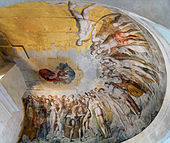This article includes a list of references, but its sources remain unclear because it has insufficient inline citations .(October 2014) (Learn how and when to remove this template message) |

The Château de Tanlay at Tanlay (Yonne) is a French château built in Burgundy during the sixteenth and seventeenth centuries, famous for its beauty and the setting. The walls are of limestone under tall sloping slate roofs à la française, surrounding three sides of a central court with cylindrical towers at its four corners. The château is entirely encircled by its rectilinear moat and approached on axis across a bridge marked by paired obelisks through a gatehouse (illustration) built in 1558, which straddles the low balustrade and projects forward into the moat. The perfect symmetry of the cour d'honneur is part of Tanlay's serene charm.

Tanlay is a commune in the Yonne department in Bourgogne-Franche-Comté in north-central France.

Yonne is a French department named after the river Yonne. It is one of the eight constituent departments of Bourgogne-Franche-Comté and is located in the northwest of the region, bordering Île-de-France. It was created in 1790 during the French Revolution. Its prefecture (capital) is Auxerre and its postcode number is 89.

A château is a manor house or residence of the lord of the manor or a country house of nobility or gentry, with or without fortifications, originally—and still most frequently—in French-speaking regions.
Contents

The foundations are in part those of the thirteenth-century château-fort. The rebuilding in Renaissance style is owing to the brother of the Admiral de Coligny, François de Coligny d'Andelot (1521-1569), who inherited the site in ruinous condition in 1547 and whose construction campaigns of 1555-1568 during the Wars of Religion, when Tanlay was a center of Huguenot resistance, left the residence uncompleted. Building was recommenced afterwards by Michel Particeli d'Hemery, the surintendant de finance under Mazarin, who completed the château to designs by Pierre Le Muet between 1643 and 1649. [1] Since 1700 the property has remained in the family of the man who was created marquis de Tanlay in 1705.

The Renaissance is a period in European history, covering the span between the 14th and 17th centuries and marking the transition from the Middle Ages to modernity. The traditional view focuses more on the early modern aspects of the Renaissance and argues that it was a break from the past, but many historians today focus more on its medieval aspects and argue that it was an extension of the middle ages.

François d'Andelot de Coligny was one of the leaders of French Protestantism during the French Wars of Religion. The son of Gaspard I de Coligny, he was the younger brother of Odet, cardinal de Châtillon and Gaspard de Coligny the admiral.

The French Wars of Religion were a prolonged period of war and popular unrest between Roman Catholics and Huguenots in the Kingdom of France between 1562 and 1598. It is estimated that three million people perished in this period from violence, famine, or disease in what is considered the second deadliest religious war in European history.

The house is also renowned for its gallery painted in trompe l'oeil and for the frescoes in the Tour de la Ligue ("Tower of the Huguenot League"), in which the antagonists of the War are represented in the guise of Olympic deities, and for its mellow stone and its remarkable canal, moats and grounds, which include a nymphaeum or théâtre d'eau by Pierre Le Muet.

A nymphaeum or nymphaion, in ancient Greece and Rome, was a monument consecrated to the nymphs, especially those of springs.


















